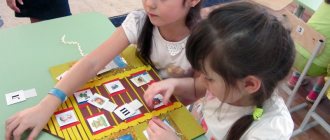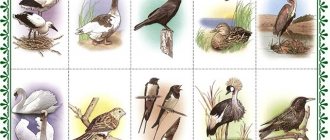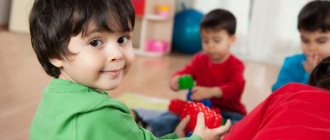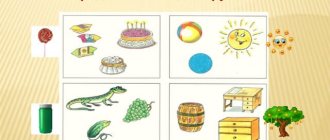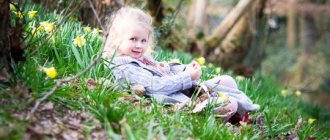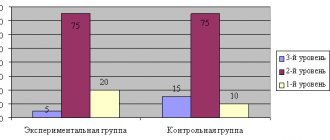Speech games in the 2nd junior group
Card index “Didactic games in the 2nd junior group
“Introduction to sound reality and the development of voluntary hand movements”
"Guess what it sounds like"
Goal : To introduce children to the sounds of the world around them, to isolate and recognize them.
Progress: The teacher shows the objects one by one and demonstrates how they sound. Then the teacher offers to solve riddles. He closes the screen and acts with different objects, and the children recognize which objects the different sounds belong to. Explains that there are many sounds in the world and they all sound differently.
"Watch"
Goal: To develop children's speech attention.
Progress: V-l: Listen to how the clock ticks: “Tick-tock, tick-tock,” how the clock strikes: “Bom-bom...”. In order for them to walk, you need to start them: “tri-truck...”! .
- Let's wind up a big clock (children repeat the corresponding sound combination 3 times); Our clock goes and first ticks, then strikes (sound combinations are repeated by the children 5-6 times).
- Now let’s wind up the small clock, the clock goes and sings quietly, the clock strikes very quietly (the children imitate the movement and ringing of the clock with their voices each time).
"Bear cubs eat honey"
Goal : To develop the articulatory apparatus of children.
Progress: The teacher tells the children that they will be bear cubs, and bear cubs really love honey. He suggests bringing your palm closer to your mouth (with your fingers) and “licking” the honey - the children stick out their tongues and, without touching their palm, imitate that they are eating honey. Then, lifting the tip of the tongue, remove it. (Mandatory demonstration of all actions by the teacher.)
The game is repeated 3-4 times.
Then the teacher says: “The bear cubs are full. They lick the upper lip (show), lower lip (show). They stroke their tummies, saying: “Oooh” (2-3 times).
"The Frog and the Little Frogs"
Goal: To develop children's speech attention.
Progress: The teacher divides the children into two groups: large and small frogs. He says: “Big frogs jump into the pond, swim in the water and croak loudly: “Kva-kva” (children imitate that they are swimming and croak loudly)
Little frogs also jump into the pond, swim, and croak quietly (children imitate the actions and croak quietly). All the frogs got tired and sat down on the sand on the shore.” Then the children change roles and the game is repeated.
"Let's feed the chicks"
Goal: To develop the speech apparatus of children.
Progress: (I am the mother bird, and you are my little chicks. The chicks are cheerful, they squeak: “pee-pee,” and flap their wings. The mother bird flew for tasty crumbs for her children, and the chicks fly merrily and squeak The mother flew in and started feeding her babies (the children squat down, raise their heads up, the chicks open their beaks wide, they want tasty crumbs.
(The teacher tries to get the children to open their mouths wider.) The game is repeated 2-3 times.
"At the doctor"
Goal: To develop the articulatory apparatus of children.
Progress: The doll is a doctor. She wants to see if the children's teeth hurt.
Q: Show the doctor your teeth (the teacher with the doll quickly walks around the children and says that everyone has good teeth. Now the doctor will check if you have a sore throat. Whoever she approaches will open his mouth wide (the children open their mouths wide).
The doctor is happy: no one has a sore throat.
"Guess what it sounds like"
Goal : Continue to isolate and recognize the sounds of individual musical instruments.
Progress : The teacher shows musical instruments one by one and demonstrates how they sound. Then the teacher offers to solve riddles. He closes the screen and acts with different instruments, and the children recognize what different sounds belong to.
"Recognize by voice"
Goal: To clarify and reinforce the correct pronunciation of sounds.
Progress: The teacher shows the toys and asks who it is, asks to say how it screams. The screen is closed and one subgroup of children takes the toys and takes turns speaking for their animals. Another group guesses who shouted.
“Who lives in the house? »
Goal: To reinforce the correct pronunciation of sounds. Develop children's speech breathing.
Progress: (The teacher shows a picture of a dog). Who is this? The dog barks loudly: “aw-aw.” And who is this? (children's answers) The puppy barks quietly (children repeat the sound combination 3-4 times). (The teacher shows a picture of a cat). Who is this? The cat meows loudly: “Meow-meow.” And who is this? (children's answers) The kitten meows quietly.
Let the little animals go home (the pictures are put away behind the cubes). Guess who lives in this house: “av-av” (pronounced loudly? (children’s answers) That’s right, a dog (shows a picture). How did she bark? (children’s answers).
Guess who lives in this house: “meow-meow” (pronounced quietly? How did the kitten meow?
Similarly, children guess who lives in other houses and repeat sound combinations several times.
“Who is screaming? »
Goal: To develop children's speech attention.
Progress: The mother bird had a little chick (puts out pictures). His mother taught him to sing. The bird sang loudly: “chirp - chirp” (children repeat the sound combination). And the chick answered quietly: “chirp-chirp” (children repeat the sound combination 3-4 times). The chick flew and flew far away from its mother (moves the picture of the chick further away). The bird is calling its son. What does she call him? (Children, together with the teacher, repeat the sound combination). The chick heard its mother calling him and chirped. How does he tweet? (Children say quietly). He flew to his mother. The bird sang loudly. How?
"Call Your Mom"
Goal: To reinforce the correct pronunciation of sounds. Develop intonation expressiveness.
Progress: All children have object pictures with baby animals. Educator: “Who is your picture, Kolya? (chicken) Who is the chicken's mother? (chicken) Call your mother, chicken. (Peep-pee-pee) The teacher imitates the clucking of a chicken and shows a picture.
The same work is carried out with all children.
"Answer me"
Goal: To reinforce the correct pronunciation of sounds. Develop intonation expressiveness.
Progress: Educator: This is a goat (showing a picture). How is she screaming? Who is her cub? How does he scream? This is a sheep (show picture). How does she bleat? And how does her baby lamb scream? etc. Pictures are displayed on flannelgraph.
The teacher hands out pictures of animals and birds to the children. The cubs are walking (children leave the tables, nibble grass, nibble crumbs. Whose mother or whose father will call the cub. He must shout - answer them - and run - put the picture next to them.
The teacher pronounces the cry of an animal or bird. The child with the cub depicted makes sounds and places the picture on the flannelgraph.
on speech development
"WONDERFUL BAG"
Goal: focus on the gender of a noun when defining an object by its characteristics.
Materials: hare, carrot, cucumber, apple, tomato, bag.
Let’s tell the children something like this: “A hare came to our kindergarten. Running bunny, what's in your bag? Can I have a look? What is this? (Carrot.) What carrot? (Long, red.) Put the carrots on the table. And what's that? (Cucumber.) What cucumber? (In the same way we take out a tomato, apple, etc.)
Now the hare wants to play with you. He hid all the vegetables and fruits in a bag. The bunny will put his paw into the bag, take a vegetable or fruit and tell you about it, and you must guess what the bunny has in his paw. Listen carefully. It is long and red. What is this? (Carrot.) It is green and long. What is this? (Cucumber.) It is round and red. What is this? (Apple.) It is round and red. What is this? (Tomato.)"
If the children answer the last two questions incorrectly, we repeat, emphasizing the pronoun in our voice: “Listen again. It is round and red. It's round and red.
Now find and put vegetables in the bag. What's left? (Apple.) Apples are fruits. Thank you, hare, for coming to us. Goodbye".
"MULTI-COLORED CHEST"
Goal: learn to focus on endings when agreeing words in gender.
Materials: chest, object pictures: egg, cookies, jam, apple, towel and other objects designated by neuter and feminine nouns, according to the number of children.
Let's put a chest with pictures on the table. We will invite the children to take out the pictures one at a time, while asking questions: “Which egg? Which
matryoshka? Etc. The interrogative pronoun agrees with the noun and helps the child correctly determine the gender of the latter.
If the pictures show 2-3 objects, the game will take on a new meaning: the child will be able to practice forming the nominative plural forms of nouns.
"TEREMOK"
Goal: focus on the ending of a verb in the past tense when agreeing it with a noun.
Materials: wooden house, toy animals: mouse, frog, bunny, fox, wolf, bear.
Let's put a tower on the carpet. We will place the animals near the tower. We will tell a fairy tale, encouraging children to take part in the telling.
— There is a tower in the field. She ran to the tower... who? That's right, mouse. (Children give hints based on the meaning of the verb and its ending.) “Who lives in the little house?” Nobody here. The mouse began to live in the little house.
A frog galloped up to the tower. Etc. In conclusion, let's summarize:
- Listen to how we say: the frog galloped, and the bunny galloped; The fox came running, and the wolf came running.
“WHAT’S MISSING?”
Purpose: to practice the formation of genitive plural forms of nouns.
Materials: pairs of objects: nesting dolls, pyramids (large and small), ribbons (of different colors and different sizes - long and short), horses, ducklings, Pinocchio, bag.
Pinocchio appears in front of the children with a bag. He says that he brought toys for the guys. Children look at toys. They call them. They put it on the table.
We comment:
- What is this? Matryoshka. Let's see what's inside the nesting doll. Another matryoshka. Place them next to each other. Vova, now take out the toy. What is this? (Pyramid.) Is there another pyramid? Etc.
- Remember what items are on the table. There are pyramids, nesting dolls, and ducklings. Pinocchio will play with you. He will hide toys, and you will have to say which toys are gone: nesting dolls, pyramids, ducklings or something else.
Three pairs of objects remain on the table: nesting dolls, pyramids, horses. Children close their eyes. We hide the nesting dolls and put ribbons in their place. (“Who’s missing?”) Then we hide the ribbons and put pyramids in their place. (“What’s missing?”) Etc. Finally, we remove all the toys and ask: “Which toys are missing?”
“WHERE ARE OUR HANDS?”
Purpose: to practice the formation of genitive plural forms of nouns.
Children sit on chairs. Let's address them, inviting them to a joke or a game with intonation:
Where are our pens? Our pens are gone! (We hide our hands behind our backs. Children do the same.) Here are our hands! (We show our hands and play with our fingers.)
- Where are our legs? Our legs are gone! (Children hide their legs under the chair.) Here are our legs! (They stomp their feet.)
- Where are our pens? What's missing? (Pens.) Here are our pens! - Where are our legs? What's missing? (Legs.) Here are our legs!
The game is repeated 2-3 times.
"LOTTO"
Purpose: to practice the formation of plural forms of nouns (in the nominative and genitive cases).
Materials: pictures depicting objects in the singular and plural (matryoshka - nesting dolls, bucket - buckets, wheel - wheels, ring - rings, etc.).
We distribute pictures to the children, keeping the paired ones. We explain the conditions of the game:
- This is a game of attention. I will show pictures. Each picture shows a toy. Anyone who has a picture with the same toys should quickly say so. For example, I have a wheel. And Vera has wheels. Faith must quickly say, “I have wheels,” or “I have many wheels.” Toys must be named.
The one who hesitates gives his picture to an adult. If the child quickly and correctly names the toy, we give our picture to him.
At the end of the game, the losers (who do not have pictures on their hands) are offered comic tasks: jump on one leg, jump high, sit down three times, etc. We come up with tasks together with the children.
"ORDERS"
Purpose: to practice the formation of imperative forms of the verbs to jump, to go.
Materials: truck, mouse, bear.
We bring a truck and a mouse and a bear into the room. We address the children:
— Do you want the mouse and the bear to ride in a truck? If you want, ask them. You have to say: “Bear, go!” You can also ask the mouse and the bear to jump: “Mouse, jump!” (Requests are accompanied by actions with toys.)
- Oleg, who do you want to ask, a mouse or a bear? What will you ask for?
The game continues until the children's interest in it runs out.
“BEAR, LEAN!”
Purpose: to practice the formation of imperative forms of the verbs lie, sing.
Materials: teddy bear (voiced toy).
A bear cub comes to visit the children. We tell you that he knows how to carry out orders. You can ask the bear: “Bear, lie down on your side... lie down on your back... lie down on your tummy.” He can also sing, you just need to ask: “Bear, sing!” (The story is accompanied by actions with the toy.)
At the request of the children, the bear cub performs various tasks. If the child finds it difficult to formulate the task, we ask leading questions: “Do you want the bear to lie down? On the tummy or on the back? Let’s say together: bear, lie down on your tummy.”
You can give the bear cub other tasks: go (down the hill), jump, dance, write a letter, etc.
"HIDE AND HIDE"
Goal: correctly use prepositions with spatial meaning in speech (in, on, about, under, before).
Materials: truck, bear, mouse.
The bear and the mouse are visiting the children again. The guests began to play hide and seek. The bear leads, and the mouse hides. We invite children to close their eyes. We say:
— The mouse hid. Open your eyes. The bear is looking: “Where is the mouse? He’s probably under the car?” No. Where is he, guys? (In the cockpit.) Look where he got into!
Close your eyes again, the mouse will hide again. (We put the mouse on the cabin.) Where is the mouse? Guys, tell the bear!
In the same way, children, together with the teddy bear, look for a mouse that is hiding under the car, near the car, in front of the car.
Games and exercises with grammatical content can be included in group lesson scenarios, or can be carried out at the request of children with small subgroups during leisure hours. You can organize games with children, with the help of which they would learn to correlate the producing and derivative words. This is done on the basis of nouns denoting animals and their young. The formation of methods of verbal word formation is closely related to form formation. It is carried out in outdoor games, dramatization games, and special didactic games.
"LOST"
Goal: match the name of the animal with the name of the baby.
Materials: toy house, animals (toys): duck and duckling, hen and chick, goat and kid, cow and calf, horse and foal.
Let's place adult animals around the room. Their cubs are on the carpet in the house. Let's invite the children to find out who lives in the house.
- Let's get a look. Quack-quack-quack - who is it? Duck? We take out the toy from the house. Is the duck big or small? Small? This, guys, is a duckling. Little duckling. And the duck is his mother. Help the duckling find his mother duck. Vasya, take the duckling. Look for the duck.
- Whose voice is this - pi-pi-pi? Who is this? (We take out the chicken.) Who is the chicken's mother? How does a chicken cackle? How does the chicken respond? Look, Olya, for the chicken, the chicken’s mother.
The rest of the characters are played out in a similar way. When all the babies have mothers, the adults and cubs are placed together. Let the children look at them, say the words: duck - duckling, hen - chicken, etc. Then the animals leave by car to visit other children.
"WHOSE'S VOICE?"
Goal: to distinguish between adult animals and young animals by onomatopoeia, to correlate the names of an adult animal and its young.
Materials: toys: mouse and little mouse, duck and duckling, frog and baby frog, cow and calf.
Animals come and visit children. The animals want to play. Children must guess whose voice they heard.
- Moo-oo - who moos like that? (Cow.) Who moos lowly? (Calf.)
Kwa-kwa—whose rude voice is this? And who croaks thinly? The frog is large and croaks in a rough voice. And her cub croaks thinly. Who is the baby frog?
The rest of the toys are played in the same way. After the game, children can play with toys. To receive a toy, the child must call it correctly (“Frog, come to me!”, “Duckling, come to me!”).
"HOUSES"
Goal: use the names of baby animals.
Materials: tray with toys: squirrels, hares, ducklings, mice, etc. - according to the number of children, building material.
We bring a tray of toys into the room. We say that children should build houses for the kids. Everyone must first decide for whom he will build a house, and correctly ask an adult: “Please give me a duckling (little squirrel).”
If necessary, you need to suggest the whole word or just the beginning and ask the child to repeat the name.
We lay out building material on the carpet. Children build houses for their animals and play.
"FRIENDLY GUYS"
Goal: to correlate the names of adult animals with the names of their babies, to activate the names of baby animals in speech.
Materials: squirrel and fox.
Let's explain to the children the content of the game:
— Now we’ll play the game “Friendly Guys.” Get into pairs. Now line up in two columns. The first column is squirrels, the second is fox cubs. Here are your houses (we place chairs at different ends of the room, on which we sit the squirrel and the fox). If you hear dance music, dance and run - frolic on the lawn. At the command “Danger!” run home to your mothers. The one who gets it together the fastest wins.
The game is repeated 3-4 times.
Plastic sketches and exercises also contribute to the activation of the names of baby animals and their correlation with the names of adult animals. For example, an adult takes on the role of a mother hen, and children take on the role of chickens. A hen with chicks walks through a clearing. Everyone is raking the grass, looking for worms, drinking water, and cleaning their feathers. At the command “Danger!” The chickens run under the wing of their mother hen.
Games without visual aids
There are two types of word games with younger kindergarten students: only speech-based and with partial use of visual material or objects. Among the games of the first type are:
- games - “add-ons”;
- play with literary works and folklore;
- finger games.
In all three versions of such games there is a general rule: they are played on the basis of a text that is well known to children. Children will have to complete simple tasks: add a word to a rhyme or riddle, show the actions expressed in the work with gestures, facial expressions, movements of fingers or palms. Since imitation is highly developed in younger preschoolers, the adult leading the game must speak the correct language, have a positive attitude and be able to express the necessary emotions. The desire of children to continue to engage in this type of activity depends on how educators or parents present the game.
Family puns help establish close emotional contact between parents and children
Table: examples of word games with children of the younger group based on texts
| Name and objectives of the game | Content |
| “Add a word” To teach children to carefully follow the progress of the story, listen carefully to the sound of the words, add the appropriate word according to their meaning. Develop attention, form the first idea of a rhyme. Increases interest in artistic expression and folklore. | A simple poem is taken, understandable to children, with which they are already familiar (but have not learned). The teacher reads the line, stopping before the last word; the children must say this word. Folklore (“Water, water”, “Ladushki”, “Fig, bris!”) is suitable for this game, as well as poems by A. Barto from the “Toys” cycle, Korney Chukovsky “Zakalyak”, “Chicken”. |
| “Guess the riddle” Develop logical thinking and language in children, awaken interest in solving riddles, increase the ability to hear the riddle to the end and only then name the answer. | An adult asks a riddle, the answer rhymes with the main text, and the children say the answer. From the second half of the year, you can introduce puzzles, the answer to which does not rhyme; you need to search, focusing only on the content of the text. Rhyming riddles:
Riddles without rhyme:
|
| “Show the doll a poem” Teach children to pronounce individual sentences of a poetic text, accompanying them with appropriate actions to develop coherent speech, intonation expressiveness, and attention. Cultivate a love of literature, folklore, and theatrical activities. | Educator: - Guys, the doll Olya came to visit us. Love listening to poetry and know a lot of interesting poems. Let's not only tell them to Olya, but also show them. The teacher reads a poem or nursery rhyme, showing the necessary gestures and movements, and the students repeat after him. For example:
Children's rhymes “Goo-tu-tu”, “Magpie-crow”, “Ladushki”, poems “The bear has a big house”, “The gray hare is sitting”, songs “Cooking, cooking”, “Little gray kitten” is suitable for playing” . |
| Finger games. To develop coherent speech in children, improve fine motor skills, coordination of speech, movements of fingers and palms. Develop organization, love for common games, perseverance. | These games are similar to a game, but all the actions contained in them are represented by movements of the fingers and palms.
|
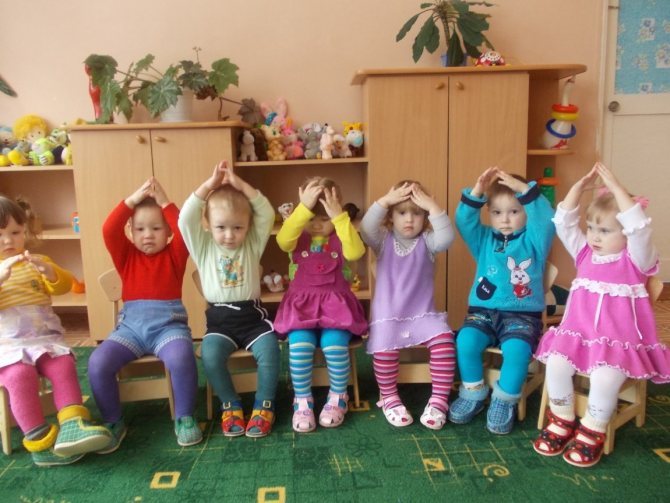
Playing with poetry is an activity that preschoolers love
Exercises for the development of vocal breathing, the formation of correct pronunciation and articulation of sound “Song of a mosquito, a bee, a train”, “Obedient tongue”, “Tell me like me” are also performed without visualization in kindergarten at a younger age. The teacher or parents clearly pronounce the sounds, indicate the correct position of the lips and tongue, and the child repeats according to their pattern.
Games for developing speech for children 3 - 4 years old.
Educational language games for children 3-4 years old are an important element in the development of the child as a whole. Every mother strives to give her child the best from a very early age. However, due attention should be paid to the child’s speech and diction.
Every year the child becomes more mature and each time he needs new information. In order to properly develop a child’s speech, it is not at all necessary to attend various paid classes; you can teach your child to speak clearly and clearly in the form of a game at home.
Believe me, these simple home games are much more effective than lessons with a teacher. Of course, this is the case if there are no violations in pronunciation.
In addition, such games will not seriously save the family budget, but the child will be satisfied with the cozy atmosphere at home and is ready to learn with renewed vigor.
At the age of 3-4 years, the child should happily accept various new games and happily satisfy the various requests of the parents.
This article presents games that will help children 3-4 years old develop speech and diction.
“Go! No, go"
This game evokes a storm of emotions in children; its essence lies in the correct pronunciation of the word “go”. You will need: a car with a body, a small toy.
A car drives up with a rabbit sitting in it and says: we need to load firewood in the forest, the child must pretend that he loaded it and say: “Here, go ahead!” If you make a mistake, correct it and play again.
"Shop"
This game is loved by many girls, because, as a rule, girls love everything related to shopping and shopping. Your task is to build an impromptu store and put goods on the shelves in it.
Let your child be the seller and you the buyer. The most important condition is that the product is sold only if the word is pronounced correctly and the product is guessed and only one sound is pronounced.
For example: I need “m”, the child must look at the product on the shelves and guess that it is a typewriter.
"Simple riddles"
There is nothing complicated in such a game, you need to guess the riddle from everything that can lead you to the correct answer.
For example: lying in the bathtub, when water gets into it, foam forms and your hands become cleaner. The correct answer is soap.
We lie on it whenever we get tired, and in the morning we can’t be torn away. The correct answer is pillow.
"Human"
You will need pencils and a piece of paper. Ask your child to draw a person or characters and come up with their first and last name.
Also let me imagine and draw what kind of house this person has, what kind of pet he has, his workplace.
When he arrives at the workplace, ask him to design his character's clothes, dishes and toys. Finally, ask your child to tell you more about their character based on their drawing. This game perfectly develops memory and imagination.
“Describe the toy”
You will need any toy that is in the house, let the child carefully examine it and hide it.
Let me describe this in as much detail as possible, now attach a badge or rubber band to the same toy and show it to the child again, asking the question “what has changed about it.” He must remember the shape of the toy in order to find the difference. This game is great for developing memory and attention.
"Ring"
You will need a mobile phone and an imaginary interlocutor. Let the child call (grandfather, grandmother, sister or friend) and talk to him about different topics.
At the same time, follow his conversation; he must say goodbye before starting the conversation, and also say “thank you” and “goodbye.”
Also ask the child to tell the other person how he spent his day today and what he was doing. With the help of such a game, you can perfectly establish etiquette standards in your child and develop speech.
"Antonym"
With this game you will introduce your child to antonyms and improve his language skills. You must name a couple of words, and the child must prove the opposite.
For example: the card is white, and the child must answer - the card is black or the tree is tall - no, short.
“What is he like?”
You will need some object or toy, whatever, and the child must describe it in detail. For example: there is a machine, what is it? – red, fast, with black wheels, etc. Here’s a marker, what is it? – green, bright, etc.
You can also switch roles, you can describe a product or item and the child must guess it. For example: red, airy, round - this is a ball.
Language development games for children aged 3 to 4 years will help expand their vocabulary. This kind of game can be played even when you go to the market or store, I show him any product on the shelves and let him describe it in as much detail as possible.

